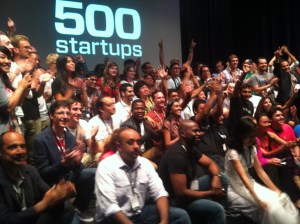Want smarter insights in your inbox? Sign up for our weekly newsletters to get only what matters to enterprise AI, data, and security leaders. Subscribe Now
The hip way to start a tech company is definitely via an accelerator. But for how long?
The number of accelerators has grown from just a handful a few years ago to more than 200 globally today. They help startups with small amounts of funding and liberal doses of training, coaching, and connections, but each is constantly seeking talent, requiring investment, and spitting out a newly-minted set of startups two or three times a year.
Can that many accelerators continue to coexist? Or even exist?
That’s just one of the questions Paul Singh of 500 Startups, Debbie Landa of GrowLab, and about 50 other managing directors of accelerators will try to answer at Grow Conference in mid-August in Vancouver, Canada. Directors of accelerators from South America, Africa, Europe, the Middle East, India, China, and of course the U.S. and Canada will be in attendance.
“Accelerators are getting squeezed on both sides,” Singh told me last week. “On one side there’s the sheer number of accelerators, and on the other side founders are demanding more — more demo days, more events, more mentors, more (and better) startups in each cohort.”
What you used to be able to do with one or two people now takes five to seven, Singh said, citing one accelerator that puts on an astounding 30 public events each year. As a result, he added, “I really wouldn’t wish running an accelerator on my worst enemy — it’s very tough.”
 In the ’90s, we used to call accelerators incubators, says Landa, who is the driving force behind the Grow conference. Most incubators ended up failing.
In the ’90s, we used to call accelerators incubators, says Landa, who is the driving force behind the Grow conference. Most incubators ended up failing.
Incubators were less focused on investment than on mentoring entrepreneurs through the early stages of the company life cycle. And it’s precisely to save today’s crop of accelerators from passing prematurely that Grow is hosting its closed-door symposium.
Back to the beginning
In 2008 entrepreneur Paul Graham founded Y Combinator, the archetype of today’s accelerators, after selling ViaWeb and thus “solving the money problem.” Since then, Y Combinator has launched over 500 companies, each with what Graham says is an average $45.2 million valuation.
Another long-standing accelerator, TechStars, has launched 168 startups, 90 percent of which are still in operation. 500 Startups is another major competitor, with plans to launch far more startups than its name suggests and a strong track record of going global to find them.
Certainly the most prestigious accelerator, Y Combinator invests little, but attracts follow-on rounds from legendary VCs and well-heeled businesspeople and investors like Yuri Milner.
Success like that breeds copycats, and lots of them.
“In late 2009 there were only about 20 accelerators around the world,” Singh told me. “But by 2012 there were about 150.”
The number of accelerators has been doubling annually, and that’s brought its own set of problems — problems that Landa, Singh, and other want to address now, before there’s another incubator-style meltdown.
Accelerate this!
“With the rate accelerators are opening up … there’s challenges,” Landa says.

Above: GrowLab
One of the reasons is that accelerators have hard costs that other types of investors simply don’t. A Sand Hill VC, for instance, feels no inclination to provide office space for his or her investments, but an accelerator typically does. And while VCs don’t organize very many informative and educational events for young entrepreneurs, most accelerators host at least one a month, each of which has to be meticulously planned, managed, and executed.
“Accelerators are trying to cover fixed costs via sponsorships, paid events, even by charging startups … it’s hard!” Singh says. “The bar keeps rising.”
And those are the easy problems.
The truly hard problem that accelerators face is finding, attracting, and developing the best talent. With the number of accelerators doubling annually, there’s a lot of competition for good startups and good founders. Accelerators no longer have the pick of the litter; they have to scrap for talent, working hard to differentiate themselves as the best place for an entrepreneur to risk his or her time and energy and startup.
It’s unbelievably critical to get the best startups, Singh says, because only the very best startups generate enough follow-on venture capital, investment, and growth to pay for the entire operation of an accelerator.
“Most people treat early stage venture capital as an asset class — if you invest in enough startups, you’ll be fine,” he told me. “But instead it follows a power law. So, if you don’t have the best startups, you won’t make it.”
In other words, without a Reddit, an AirBnB, or a DropBox, there’d be no class of 2014 at Y Combinator.
Accelerate yourself
The biggest problem, perhaps, is that accelerators are not changing as quickly as the startups they are purportedly accelerating.
“The hypocrisy of accelerators is that we give you money, and you go innovate while we do business as usual,” Singh says.
 In other words, while most accelerators spend 80 percent of their resources on day-to-day operational expenses and 20 percent on marketing, Singh suggests those numbers need to be flipped. Like founders need to stop focusing completely on day-to-day tactics and product, and start focusing more on distribution, accelerators need to focus most of their attention on intake.
In other words, while most accelerators spend 80 percent of their resources on day-to-day operational expenses and 20 percent on marketing, Singh suggests those numbers need to be flipped. Like founders need to stop focusing completely on day-to-day tactics and product, and start focusing more on distribution, accelerators need to focus most of their attention on intake.
“You’ve gotta figure it all out, but what you live and die by is whether you get good founders to come,” he says.
Nothing’s completely broken yet, Landa suggests. But at the rate accelerators are opening, it’s critical to figure out these kind of challenges so that there isn’t an accelerator meltdown in 2014.
One thing neither will say is that there are too many accelerators.
“The click-baity thing to say is that there’s too many,” Singh says. “But you can’t say yet … they’re becoming more regionally focused and vertically focused.”
Landa agrees.
“There’s a lot of accelerators opening up in niche markets: enterprise, hardware, gaming accelerators, which I think is really smart.”
The challenge that the Grow conference’s symposium on accelerators will focus on, she said, is that accelerators stay ahead of the curve, learn from each other, and don’t melt down a la 1990s.


